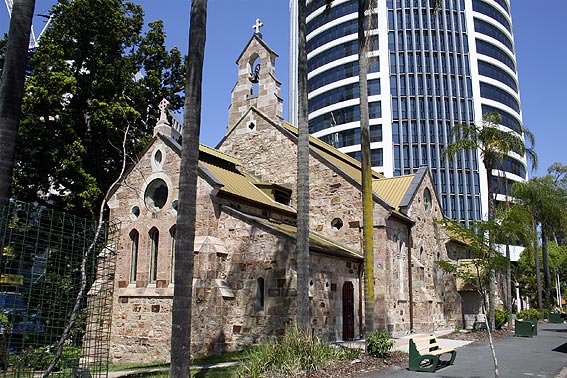
[Photograph by Trevor Bunning (October 2007)]

[Photograph by Trevor Bunning (October 2007)]
Historical and Technical Documentation by Geoffrey Cox1
© OHTA 1989, 2003, 2007, 2011, 2020 (last updated December 2020)
All Saints' Church in Wickham Terrace, Brisbane, is the oldest surviving Anglican church in the inner city of Brisbane. It was preceded by St John's Church, but the latter was demolished in 1904. Both were preceded by St Stephen's Catholic Church, which was opened some six years before, and which still stands.
Land was granted on 'Windmill Hill' in 1856 for a church to be built where All Saints' now stands. The first church on the site was built to the design of the architect Benjamin Backhouse, and opened on 23 February 1862. The 1862 building was known officially as the Wickham Terrace Episcopalian Church, or as the Wickham Terrace District Church (though unofficially as 'Brisbane Tabernacle'). It was not until 1869 that the parish was designated as All Saints'.
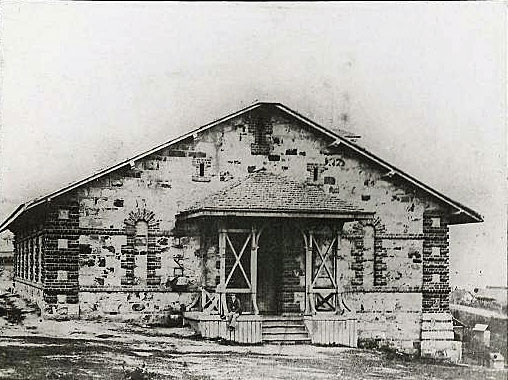
The first All Saints' Church, Brisbane, 1862
[Photograph: Henry Alcock Collection, image 692,
The University of Queensland, Fryer Library]
Plans to enlarge the original church in 1869 were frustrated when structural problems were discovered, and the present church was effectively built afresh over the floor of the original one. Opened on 8 September 1869, it was designed by the architect, Richard G. Suter, who was also a church warden of the parish. The church is rectangular in plan, without transepts, Gothic Revival in style, and constructed from local porphyry stone.2 It was not consecrated until March 1885.3
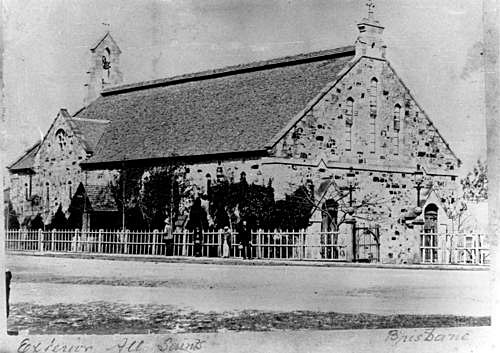
All Saints' Church, Wickham Terrace, c.1876
[Photograph: John Oxley Library, State Library of Queensland, Neg: 33161]
First Organ.
The first organ at All Saints' was installed originally in the old church, where it was used for the first time on Wednesday 3 August 1864. It was built by Thomas Jennings of London, and installed by Mr Paul Atkinson, who appears to have been the organist of the church at this time. The original instrument comprised one manual (9 stops, with preparation for 2 more) and pedals (2 stops), and the addition of a Swell organ was envisaged from the outset. A description of the instrument at the time of its installation in 1864 follows:
NEW ORGAN FOR WICKHAM TERRACE CHURCH
We have been furnished by Mr. P. Atkinson with the following description of the new organ recently put up by him in the Wickham Terrace Church, and which is to be used for the first time this evening.
The organ, which is the largest and most complete in Brisbane, was built by Thomas Jennings, of London, and cost, including insurance, &c, £175. The following is a list of the different stops:
MANUAL
Double stopt diapason
Open diapason
Stopt diapason [&] Clarabella
Principal
Dulciana
Flute harmonique
Fifteenth
Twelfth
Full mixture
metal
wood
metal
metal tenor C
metal tenor C
metal
metal
metal
56 notes
56 notes
56 notes
41 notes
41 notes
56 notes
56 notes
168 notes
Total number of pipes in great organ: 592 [sic].The great organ sound board is also prepared for a trumpet and a sharp mixture.
Compass of manual from CC to G, in altissimo 56 notes.
THE PEDAL ORGAN Compass CCC to F, 30 notes;
Bourdon bass
Flute bass
[wood]
[12 notes]
[The Flute bass is] borrowed by means of a very ingenious mechanical contrivance called an octave coupler, by which means the note can be used in octaves; the upper note alone, or the lower note alone, so that the one row of pipes with the octave coupler is as good as two stops would be without the octave coupler.The lowest 24 notes of the open diapason form the front of the organ. The wind is conveyed to those pipes by what are called conveyance pipes. The pedal bourdon pipes are placed so as to form the case of the instrument at each side.
The bass of the great organ stands immediately inside the bourdon, on two separate sound boards. These notes are also conveyanced off from the principal sound boards.
The pedal keys, which must be a curiosity and a wonder to the people of Brisbane, are made after a very fine model, radiating slightly from the centre, and having the lower and upper notes raised a little so as to meet the feet of the performer when he sits at the middle of the keyboard.
All the stops of the great organ and pedals are ranged at the right hand of the player. The left hand side is at present blank, but the organist trusts that the musical portion of the congregation will not allow this to be so long, but that they will raise funds sufficient to send for the pipes and mechanism of the "swell organ," and give him an opportunity of displaying those beautiful effects so nearly approaching to the human voice of an educated and refined vocalist, of which only the "swell" is capable.
The following description of some of the stops may be interesting:
The open diapason is of metal all through, and is considered the ground work or foundation of the organ, and is generally clearest and fullest in tone, standing out most distinctly from the others.
The stopt diapason is of wood all through, is a soft and subdued quality of tone, which is produced by having the ends of the pipes stopped with a square plug of wood, by which means they are tuned.
A stopt pipe will sound an octave lower than an open one of the same size.
The dulciana is an exquisitely sweet and pleasing quality of tone, of much smaller scale than the open diapason, and is most suitable for accompanying a solo singer, or performing any soft or delicate movement.
The flute harmonique is more powerful and piercing than the dulciana. There is a hole bored in each pipe midway between the foot and the top. It speaks an octave higher than the dulciana.
The principal is a metal stop throughout, sounding an octave above the open diapason. It is voiced much softer than the diapason.
The fifteenth is a metal stop throughout of small scale, sounding an octavo above the principal, and two octaves, or a fifteenth above the diapason; hence its name.
The full mixture is what is technically termed a compound stop. There are three pipes to each note, producing thirds, fifths, and octaves to the diapason.
The pedal bourdon is a stopt wooden pipe of large size or scale, producing a full and deep tone.4
There was a proposal in October 1874 to remove the organ either to a loft over the central (west) door or to the south-east corner of the church. It was reported that 'the question of a surpliced choir had already, for a period of two years, been before the Parochial Council,' and it was noted that the first suggested location of the organ would necessitate a precentor at the cost of £50 per annum.5 The second option appears to have prevailed, and the organ was enlarged to two manuals by William Davidson of Sydney. A special service involving the 'United Church of England choirs of Brisbane' was announced as being held on Monday 11 January 1875 to 'inaugurate the completion of the organ, which has been removed to the lower end of the church.'6 A slightly later newspaper report of 1875 gives the specification of the organ as Davidson completed it:
The Organ at All Saints' Church Wickham Terrace
The following particulars respecting the alterations and improvements recently made to the organ at All Saints' Church, Wickham Terrace, have been furnished us for publication by one of the members of the choir.
The old portion of the organ had suffered much from the effects of climate and unskilful treatment by those who had attempted to repair the defects, [and] indeed many were of [the] opinion that the expense of thoroughly renewing would be very great. The instrument was placed in the hands of Mr. William Davidson, organ builder, of Pyrmont, Sydney, with instructions to carry out all necessary repairs, and add a new eight stop "Swell organ." This work has now been most satisfactorily carried out and the instrument now consists of two sets of manuals and full compass pedals, with 24 draw stops distributed in the following manner:-
GREAT ORGAN
Bourdon
Open Diapason
Stopd Diapason bass
Clarabella
[Dulciana
Principal
Harmonic Flute
Twelfth
Fifteenth
Mixture
Trumpet
SWELL ORGAN
Bourdon
Horn Diapason
Lieblich Gedackt
Principal
Fifteenth
Mixture
Horn
Oboe
PEDAL ORGAN
Bourdon
Flute
COUPLERS
Swell to great
Swell to pedal
Great to pedal
16 feet tone
8 feet
8 feet
8 feet
[8 feet]
4 feet
4 feet
2-2/3 feet
2 feet
3 ranks
8 feet
16 feet tone
8 feet
8 feet tone
4 feet
2 feet
2 ranks
8 feet
8 feet
16 feet tone
8 feet tone
56 pipes
56 pipes
12 pipes
44 pipes
[44 pipes]
56 pipes
44 pipes
56 pipes
56 pipes
168 pipes
56 pipes
56 pipes
44 pipes
56 pipes
56 pipes
56 pipes
112 pipes
56 pipes
44 pipes
30 pipes
30 pipes
This makes 648 pipes in the "Great", 480 in the "Swell", and 60 in the "Pedal" organ, or a total of 1,188 pipes. Among the stops particularly worthy of notice may be mentioned the "horn diapason" and "lieblich gedackt" in the "Swell" and the "flute" in the "Great," all of which are of the most pleasing quality of tone. The "horn" and "oboe" also are remarkable for their rich, smooth and prompt intonation, while the full organ has the depth of tone and great brilliancy. The cost of the organ up to the present time is £500, and the congregation is [to] be congratulated on the possession of so complete an instrument, and is to be commended for the incentive given to colonial industry.7
Given the reported number of draw stops (24) and the number of pipes in the Great Organ (648) in this account, it appears that there was one Great stop of 44 pipes omitted from the list. This was obviously the Dulciana 8ft, as listed in 1864. There is a Dulciana at the Apostolic Cathedral, Hatton Vale, where some of the Jennings pipework found its way in 1950 (see below). It appears that Davidson may also have added the independent Flute 8ft on the Pedal Organ.
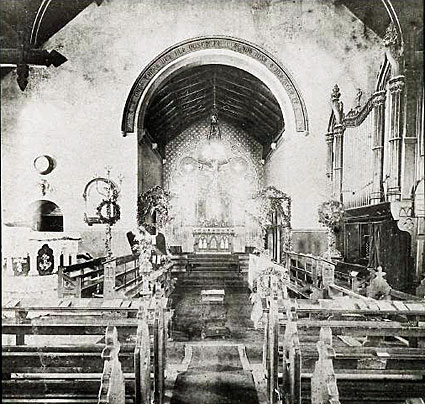
The Jennings/Davidson organ at All Saints', Easter 1898
[Photograph: Henry Alcock Collection, image 695,
The University of Queensland, Fryer Library]
The use of the organ was interrupted for a time when extensive renovations to the church were undertaken in 1893-94. The instrument was removed in 1893, and a 'pleasant entertainment' in aid of the organ fund was given in All Saints' Parochial Hall on 31 May 1894. The organ was re-opened 'after repairs and improvements' on Sunday 16 September 1894.8 Extensive repairs to the instrument were again required in 1899, when the Rector was obliged to justify the expenditure by referring to the opinion of Messrs Whitehouse and Marlor that 'the metal in the pipes of the older part of the instrument (the great organ) is of the very best that was in use at the date when that part of the organ was built.'9
The Jennings/Davidson instrument received quarterly attention by Whitehouse Bros up to at least June 1938.10 It had presumably declined into a sad state of disrepair by the time Dr Robert Dalley-Scarlett was organist at All Saints' from 1934 to 1941.11 The organ was replaced around 1939 by a Hammond electronic organ, which served All Saints' for most of the following two decades.12
Following removal from the church, the old organ was placed in storage for some years at the residence of a Mr Amos in Nundah, but it was never installed there. Some parts (including wooden pipes) were sold by Whitehouse Bros in 1948-49 to Mr Arthur Lord of Killara, Sydney, NSW, for incorporation into his four-manual quasi-theatre residence organ, which has since been broken up. Much of the Jennings pipework (from the Great) eventually found its way to the organ built by Whitehouse Bros for the Apostolic Cathedral, Hatton Vale, Qld in 1950.13
Present Organ.
Much of the pipework of the present organ at All Saints' originates in an instrument built by T.C. Lewis of London for St John's Anglican pro-Cathedral, which stood at the corner of George and Elizabeth Streets, Brisbane.
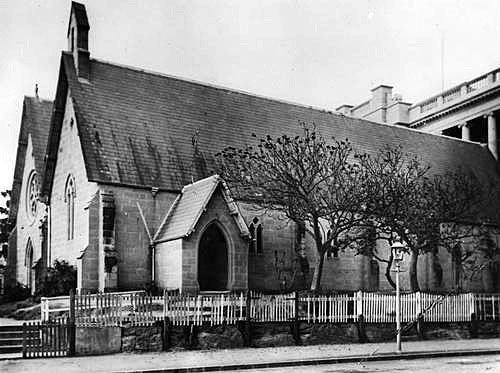
St John's Anglican Pro-Cathedral, Brisbane, c.1904
[Photograph: John Oxley Library, State Library of Queensland, Neg: 60386]
The organ had been shipped from London by May 1873:
ST. JOHN'S CHURCH ORGAN. - We have been requested to announce that this organ is now on its way here, and may be expected in a month or so - it having been shipped by the Mariette, which sailed from London on the 20th March. Mr Harris kindly delivers the organ at the wharf freight free, thus saving the congregation the sum of £30. The Rev. J. Bliss, in writing, says that, though the cost is somewhat high, there is real worth for the money. Mr Bliss also sends a certificate from G. Cooper, Esq., organist and choirmaster of Her Majesty's Chapel, St. James', which states that, after thorough examination, he has pleasure in stating that the specification has been fully carried out, that the tone and mechanism are excellent, and that he has not met with an organ possessing greater capabilities for its size.14
The organ arrived in Brisbane in the middle of July 1873 and was inaugurated at St John's with a performance of Handel's Messiah on 13 August, followed by a public service less than a week later.15 It was installed by Mr H. Sleath, a local importer of musical instruments:
H. SLEATH AND SON, Importers of Musical Instruments, George-street - Mr Sleath was born in 1828 in Warwickshire, England, and in 1862 arrived in New Zealand, where he remained through the war as a volunteer. In 1865 he purchased land in George-street, Brisbane, but went to the Gympie diggings. He returned to Brisbane and erected the first pipe organ at St. John's Church. Mr. Sleath is assisted by his son Harry - a native of this city - and imports and deals in all kinds of musical instruments.16
From the report of a rehearsal for combined choirs some years later in 1888, it appears the organ occupied more than one position during its time at St John's: '... the organ at St. John's is just now being cleaned and re-erected in a more desirable position.'17 Further overhauling was noted in 1894.18
George Sampson, who arrived in Brisbane in January 1898 to become organist of St John's Church (and later of St John's Cathedral), described much later (in 1935) the curious architecture and location of the instrument at that time in St John's, and went on to document some of the history of the instrument:
So far as construction was concerned, the pro-Cathedral of St. John seemed to me a freak. It was like two naves placed side by side, and it appeared neither homely nor intimate. The organ was at the east end of the right nave, and the altar and choir stalls at the east end of the left nave.
The organ was a two manual instrument by T. C. Lewis and Co. of London, built in the year 1873.
The instrument was dismantled and re-erected in St Luke's pro-Cathedral [i.e. St Luke's Church, Charlotte Street] in the year 1903, two [sic] new stops added to the swell organ, voix celeste, 8ft, and oboe, 8ft. The work was carried out by Whitehouse Bros.
The organ blower was for many years a kindly garrulous old chap named H. Bonnin. I cracked many a joke with him. The organ made quite a useful Church organ, but its tracker action was abominable. Indeed, it was so bad that I had to give up playing difficult music as voluntaries because of broken finger nails and strained muscles.19
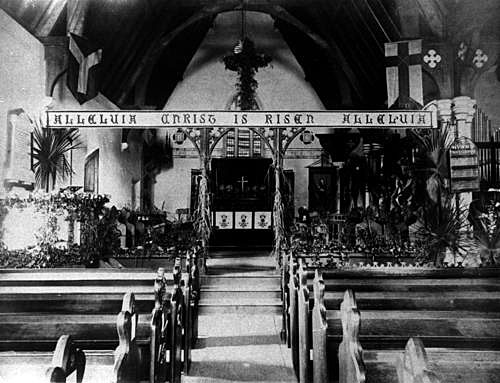
Interior of St John's Pro-Cathedral, Brisbane, 1889
[Photograph: John Oxley Library, State Library of Queensland, Neg: 19041]
The move to St Luke's Anglican Church, Charlotte Street, came shortly before the demolition of St John's Church in 1904, and St Luke's became the pro-Cathedral until the new St John's Cathedral was opened. The specification of the organ, as recorded at St Luke's, was as follows:
| GREAT Open Diapason Rohr Flute Dulciana Octave Rohr Flute SWELL Geigen Principal Lieblich Gedact Salicional Vox Angelica Geigen Principal Trumpet Oboe PEDAL Sub bass Flute Bass COUPLERS Great to Pedal Swell to Pedal Swell to Great |
8 8 8 4 4 8 8 8 8 4 8 8 16 8 |
[pipes marked 'Salicional'] [1903] [1903] [1903] |
2 combination pedals to Great
[2 combination pedals to Swell]
[Horizontal swell shutters]
Trigger swell lever
Pedalboard: straight [and flat]
Mechanical action.20
Simon Pierce has observed that the pipes of the so-called Dulciana 8ft on the Great are marked 'Salicional'.21 It is clear, therefore, that stops were re-named by B.B. Whitehouse & Co. in 1903 when additions were made to the Swell Organ. Something approaching the original nomenclature might be conjectured by observing that the Brisbane instrument conformed with a standard specification (Model 8) published by Lewis some ten years later:
| GREAT Open Diapason Rohr-flöte Salicional Octave Rohr-flöte SWELL Lieblich-gedact Geigen Principal Geigen Principal Horn, Oboe, or Trumpet PEDAL Sub-Bass Flute-Bass COUPLERS Great to Pedals Swell to Pedals Swell to Great22 |
8 8 8 4 4 8 8 4 8* 16 8 |
(ten C gvd for bass) (ten C gvd for bass) |
* The option chosen for Brisbane was obviously 'Trumpet'.
Contrary to George Sampson's 1935 account that two stops had been added to the Swell (apparently at the time of the move to Charlotte Street), an earlier newspaper report of 1906 stated that three stops had been added to the Swell Organ by B.B. Whitehouse & Co. The 1906 account also refers curiously to a total of 8 stops on that division, and accompanied a photograph of the organ at St Luke's:
ST LUKE'S CHURCH ORGAN
Mr Geo. Sampson, F.R.C.O., is organist and choirmaster at St. Luke's Church. The organ was built by Lewis and Co., London in 1873, and originally contained 15 stops. However, the time for improving the instrument came along, and B. B. Whitehouse & Co. added three extra stops to swell. The stops are: 5 on great organ; 8 on swell organ; 2 on pedals; and there are 3 couplers and 4 composition pedals.23
This account is followed a few pages later by a photograph of the organ showing a simple façade of three flats.

The Lewis organ at St Luke's Church, Charlotte Street
[Photograph: The Daily Mail (10 March 1906), p. 13]
A photograph of George Sampson, described as "Organist St Luke's Cathedral", also appears on p. 9:
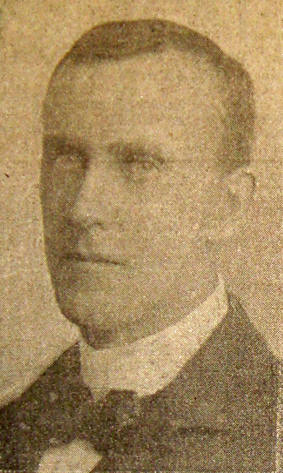
"Mr G. Sampson, F.R.C.O. (Organist St Luke's Cathedral)"
[Photograph: The Daily Mail (10 March 1906), p. 9]
The total of 15 stops in this account presumably included the three couplers. There appears, however, to be no explanation for counting 8 stops on the swell, unless a tremulant (not noted elsewhere) was included. This seems unlikely. Leaving this aside, the discrepancy between the 1906 and 1935 accounts of added stops may possibly be explained by an annotation in Salisbury's specification of the organ, which states that the Vox Angelica drew the Salicional as well.24 This was a common feature, and may account for Sampson regarding them as a single stop. In any case, Simon Pierce has observed that the pipework of the Salicional and Vox Angelica came from the same period, and it may be concluded that three stops (these two as well as the Oboe) were added in 1903.
The acquisition of this organ for All Saints' Church in the mid 1950s can undoubtedly be attributed in large part to the enthusiasm of Mr Frederic Rogers, organist at All Saints' from 1945 until his death in 1985.25 By November 1957, it was rebuilt and installed in a newly erected gallery at All Saints' by Whitehouse Bros at a cost of £3,252.3.10.26
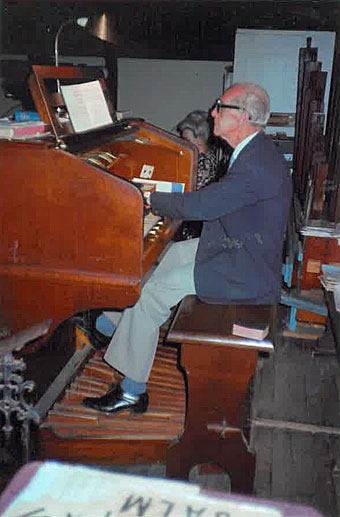
Frederic Rogers at the Whitehouse console of the 1957 rebuilt organ
[Photograph by Brian Elliff (early 1980s)]
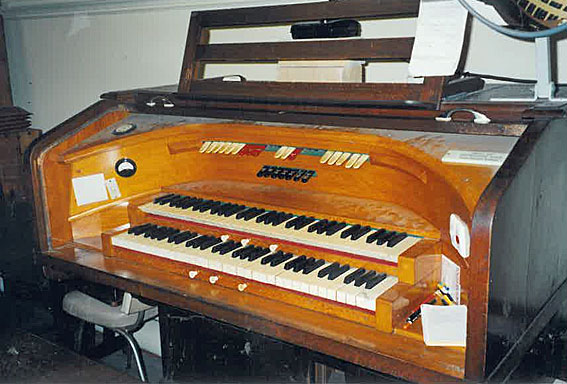
The Whitehouse console of the 1957 rebuilt organ,
formerly at the Congregational Church, Ipswich
[Photograph by John Cranley (undated)]
Although all of the existing pipework was retained at this time, some of the stop nomenclature was again changed, and the action was electrified. A second-hand horseshoe console (in the theatre-organ style) and an eight-stop swell soundboard were provided from the 1935 Whitehouse organ that had been destroyed by fire in 1953 at the Central Congregational Church, Ipswich. Additional couplers and a tremulant were provided, together with a new Flautina (Fifteenth) 2ft on the Swell Organ.27 The organ was spread across a narrow gallery, and completely rearranged, with the Great and Swell on opposite sides. The original casework was entirely discarded.
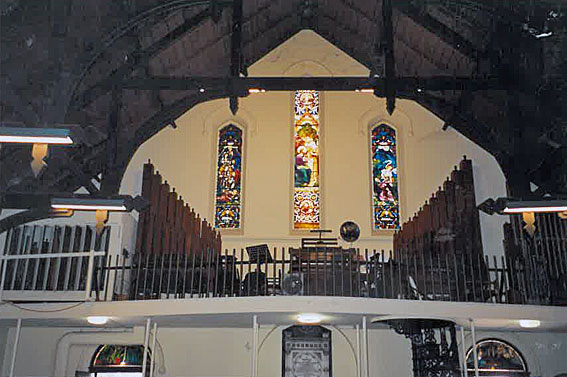
The 1957 rebuilt organ spread across the gallery
with the original casework discarded
[Photograph by John Cranley (undated)]
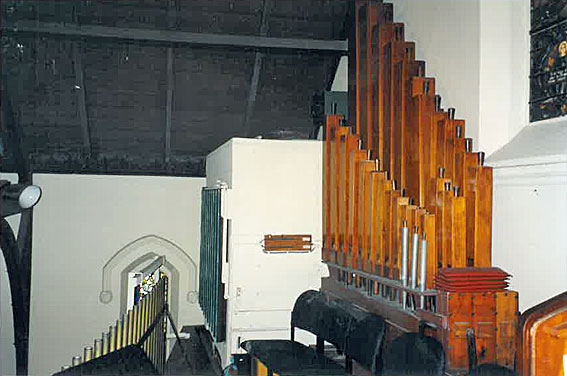
The Swell and Pedal organs, as rebuilt in 1957
[Photograph by John Cranley (undated)]
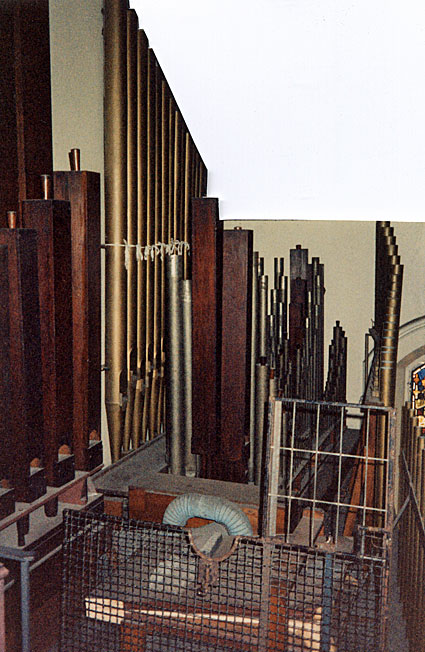
Pipework of the Great and Pedal organs, as rebuilt in 1957
[Photograph by Howard Baker (September 1989)]
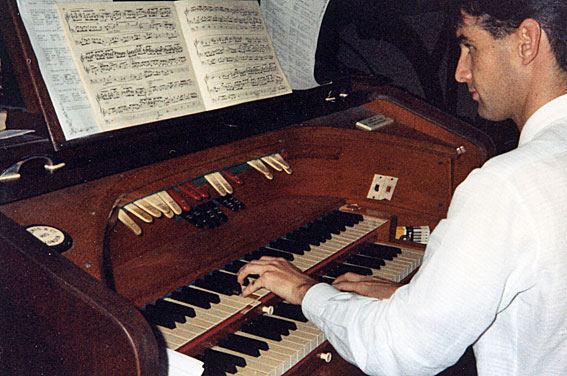
Christopher Cook at the Whitehouse console of the 1957 rebuilt organ
[Photograph: Howard Baker (September 1989)]
Dissatisfaction with the state of the organ was expressed from the mid-1980s by Christopher Cook, organist at All Saints' from 1985 to 1993, and a Heritage Report commissioned by the Church Trustees around 1990 recommended the removal of the unslightly gallery.28
Various proposals were developed in succession to reconstruct the organ with mechanical action whilst retaining the surviving Lewis pipework .The first project, formally launched in September 1992, was for a free-standing instrument at floor level by W.J. Simon Pierce.29 By late 1998, this had been abandoned in favour of a 'new organ' by Peter D. Jewkes of Sydney, to be installed in the gallery.30 Casework for the 1998 proposal was designed by Stephen Bicknell.
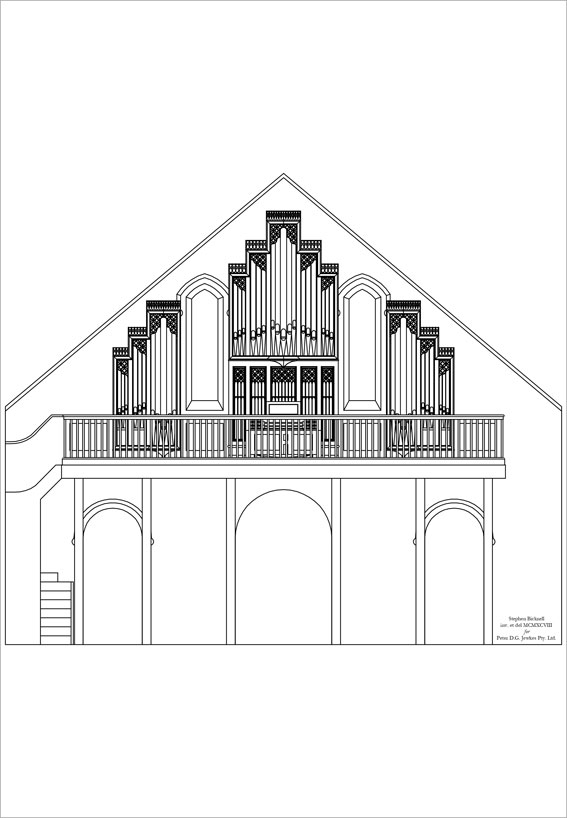
Casework design by Stephen Bicknell for the organ proposed by Peter Jewkes in 1998
[Supplied by Peter Jewkes (July 2020)]
Jewkes's proposal of 1998 was for mechanical key action in a re-designed gallery. It departed fundamentally from the Lewis tradition in placing the Great above the Swell, and obscured the central window. A report on the Jewkes/Bicknell 1998 proposal was commissioned in 2000,31 and the work did not proceed.
By 2002, a decision had been made to build an entirely new gallery and to award the contract to W.J. Simon Pierce.32 The work commenced in 2003 and was completed in 2007 as Pierce's Opus 5.
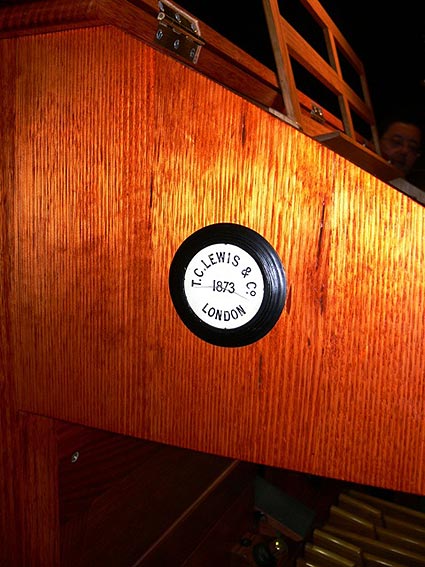
The original builder's nameplate on the present console
[Photograph by John Maidment (October 2007)]

The current builder's nameplate on the organ
[Photograph by Trevor Bunning (October 2007)
The final specification of 24 stops retains all 11 of the surviving Lewis ranks from the original organ. The three Swell stops added by B.B. Whitehouse & Co. in 1903, the Great chest (Whitehouse, 1957) and the second-hand Swell chest (Whitehouse, 1935) were all discarded. Although the original Lewis pedal chest and bellows had survived the 1957 rebuild, space constraints did not allow them to be retained.
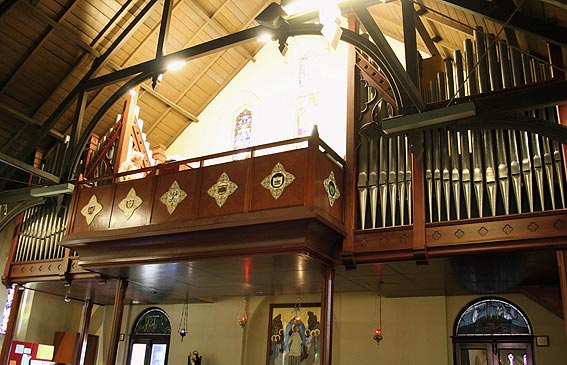
The rebuilt organ in the new gallery
[Photograph by Trevor Bunning (October 2007)]
The organ is divided on either side of the west window, with the Swell and Great on one side and the Pedal on the other. There is a detached console in the centre, facing across the gallery, and double-rise bellows located beneath the manual soundboards.
No casework from the original instrument had survived, and the new casework was based on details of the Lady Chapel screen.
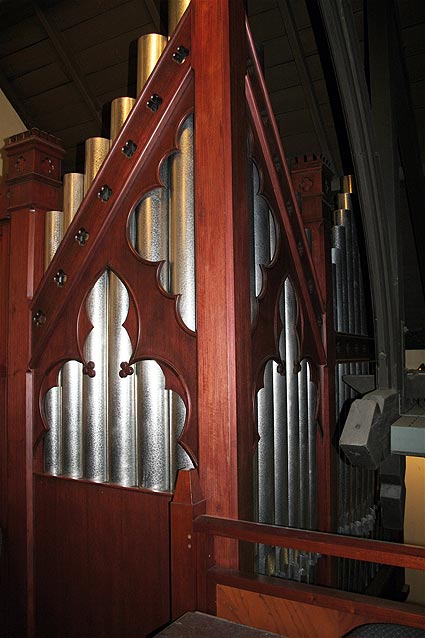
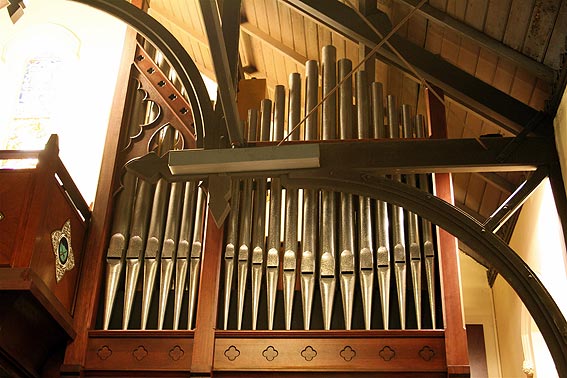
Casework details
[Photographs by Trevor Bunning (October 2007)]
Given that little of the original instrument apart from the pipework had survived the 1957 rebuild, the rebuilt instrument of 2007 is essentially a new one, albeit modeled on the work of T.C. Lewis. Pipe scales for the additional stops and soundboard design were based on those of Lewis, including some derived from his organs at the Pymble Ladies' College, NSW (1886) and St George's Uniting Church, East St Kilda, Victoria (1881). The nomenclature of the stops follows to only a limited extent the practice of Lewis:
| GREAT Bourdon Open Diapason Rohr Flute Salicional Octave Flute Quint Super Octave Mixture Clarionet SWELL Geigen Diapason Lieblich Gedact Viole de Gambe Voix Celestes Geigen Principal Flautina Mixture Trumpet Oboe PEDAL Great Bass Sub Bass Flute Flute Octave Bass Posaune COUPLERS Great to Pedal Swell to Pedal Swell to Great Swell Super Octave Swell Sub Octave |
16 8 8 8 4 4 2-2/3 2 II 8 8 8 8 8 4 2 II 8 8 16 16 8 8 16 |
A A |
[Lewis, 1873] [Lewis, 1873] [Lewis, 1873; formerly 'Dulciana'] [Lewis, 1873] [Lewis, 1873] [Lewis, 1873] [Lewis, 1873] [Lewis, 1873] [1957] [Lewis, 1873] [Lewis, 1873] [Lewis, 1873] (mechanical) (mechanical) (mechanical or electrical) (electrical) (electrical) |
Swell Tremulant
Detached console
Pedalboard: radiating concave
Compass: 56/30
Mechanical playing action (balanced)
Electric stop action
6 thumb pistons to Swell Organ
6 thumb pistons to Great Organ
12 General pistons
Reversible Swell to Great toe piston
Reversible Great to Pedal toe piston
Sequencer
Balanced swell pedal.33
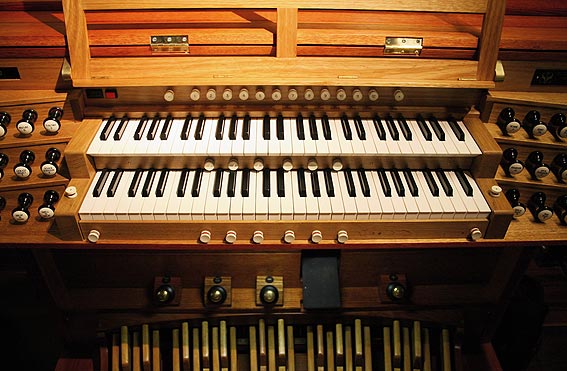
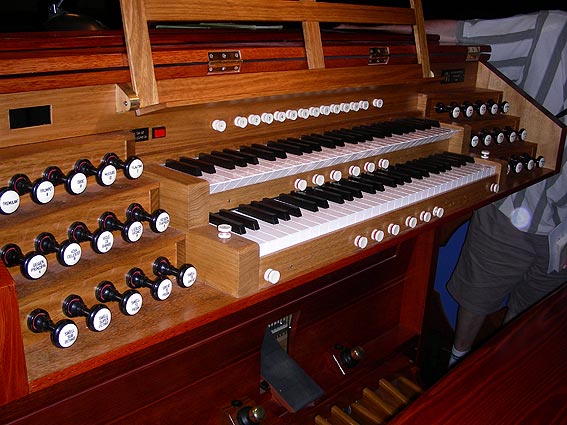
The Pierce console of 2007
[Photographs by Trevor Bunning (October 2007)]
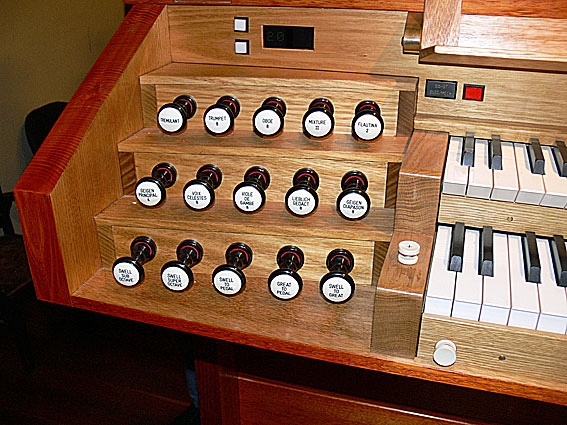
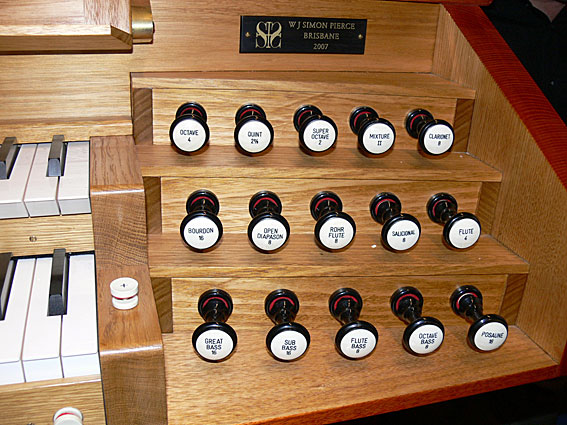
Details of the Stop Jambs
[Photographs by John Maidment (October 2007)]
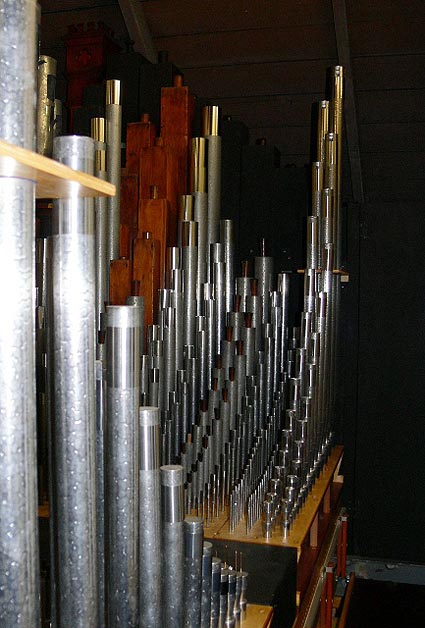
Pipework of the Great Organ,
showing the new Clarionet 8ft nearest the passage board
and the stopped metal pipes of the 1873 Lewis Flutes 4ft and 8ft
[Photograph by John Maidment (October 2007)]
_____________________________________________________________________
1 An earlier version of the first part of this article, dealing with the first organ, appeared as: Geoffrey Cox, 'The First Organ of All Saints' Church, Wickham Terrace, Brisbane,' The Organ Voice, vol. 29, no. 1 (March 2003), pp. 8-14.
2 Queensland Heritage Council, Queensland Heritage Register, location 600168; The Heritage of Australia: The Illustrated Register of the National Estate (South Melbourne: Macmillan, 1981), 4/17.
3 The Brisbane Courier (9 March 1885), p. 5; The Telegraph (9 March 1885), p. 4.
4 The Brisbane Courier (3 August 1864), p. 15. The date of installation is given as 1863 in Frederic Rogers, 'The Rebirth of an Organ,' Musical Opinion, no. 969 (June 1958), p. 595.
5 The Telegraph (14 October 1874), p. 2.
6 The Telegraph (9 January 1875), p. 2; see also The Telegraph (11 January 1875), p. 2.
7 The Telegraph (16 March 1875), p. 2.
8 The Brisbane Courier (1 June 1894), p. 5 & (15 September 1894) p. 1; see also The Brisbane Courier (17 July 1893), p. 6 & (14 August 1893), p. 7.
9 The Brisbane Courier (27 July 1899), p. 6.
10 Whitehouse Bros Ledger (1922-1940), p. 16.
11 Peter Roennfeldt, 'Dalley-Scarlett, Robert,' in The Oxford Companion to Australian Music, ed. W. Bebbington (Melbourne: Oxford University Press, 1997), p. 168.
12 Rogers, op. cit., pp. 595, 597.
13 Rogers, p. 597; Whitehouse Bros Ledger (1940-1954), p. 321; Personal communications to G. Cox from Mr J.H. Whitehouse & Kevin M. Whitehouse, c.1974; The Organ, no. 105 (July 1947), pp. 27-36.
14 The Telegraph (20 May 1873), p. 2.
15 'Diary of Events' for 19 July 1873 & 13 August 1873, in Pugh's Queensland Almanac . . . for 1874; The Brisbane Courier (11 August 1873), p. 1.
16 W. Frederic Morrison, The Aldine History of Queensland (Sydney: Aldine, 1888), vol 2, Appendix p. 262.
17 The Brisbane Courier (14 June 1888), p. 4.
18 The Brisbane Courier (18 September 1894), p. 4.
19 George Sampson, 'The Music at St John's Cathedral 1898 to 1935,' Brisbane Cathedral Notes, vol. 19, no. 242 (1 October 1935), p. 130.
20 Collected Organ Specifications of Bernie Brohan (c.1952) and Edward R. Salisbury (n.d.). The nomenclature is consistent between the two sources, although different from that recorded in Rogers, op.cit.
21 Personal communication from W.J. Simon Pierce to G. Cox, c.2003.
22 T.C. Lewis, Organ Building and Bell Founding, 8th edn (1883), p. 35 – supplied by courtesy of John Maidment; The details reproduced from this source in The Organ Voice, vol. 32, no. 2 (June 2005), p. 29, are incomplete and inaccurate.
23 The Daily Mail (10 March 1906), p. 9.
24 Collected Specifications of Edward R. Salisbury (n.d.).
25 The Courier Mail (25 March 1985), p. 8; The Sunday Mail (31 January 1985).
26 Whitehouse Bros List.
27 Rogers, op. cit.
28 Personal Cummunication to G. Cox from Christopher Cook, July 2020.
29 Loc.cit; The Organ Voice (June 1992), p. 27; OHTA News, vol. 16, no. 4 (October 1992), p. 8.
30 The Organ Voice, vol. 24, no. 3 (September 1998), pp. 18-19.
31 Harrison & Harrison Ltd, Durham, "All Saints' Church, Wickham Terrace, Brisbane: Report on the Proposals for Reconstructing the Lewis Organ" (April 2020), supplied to G. Cox by Peter Jewkes.
32 The Sydney Organ Journal, vol. 33, no. 3 (Winter 2002), p. 23.
33 Specification noted by G. Cox, 2007; Personal communications to G. Cox from W.J. Simon Pierce, January 2002, January 2003 and July 2007.